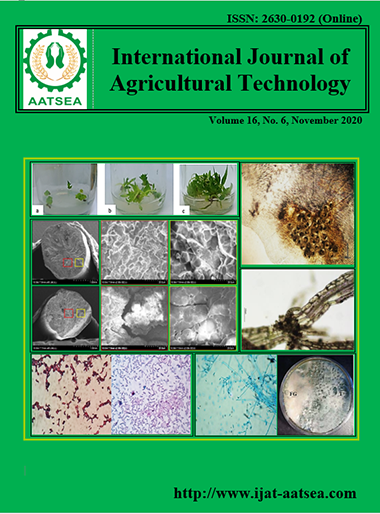Tetradecane producing biocontrol agent, Trichoderma spp. against Fusarium oxysporum in tomato (Solanum lycopersicum L.)
Main Article Content
Abstract
The secondary metabolites from Trichoderma harzianum - Tr01 and Trichoderma viride- Tr02 were extracted from liquid culture using ethyl acetate and tested for their activities against fungal pathogen, Fusarium oxysporum (Fuo4) causing wilt disease in tomato (Solanum lycopersicum L.). Two isolates of Trichoderma harzianum (Tr01), Trichoderma viride (Tr02) were antagonized F. oxysporum causing tomato wilt. T. harzianum Tr01 showed the highest chitinase activity of β-1-3-glucanase. The treated inoculated tomato with Trichoderma extract was investigated. Trichoderma harzianum (Tr01) showed strongest inhibitory activities against Fusarium oxysporum. T. harzianum (Tr01) found to produce Dodecane, tetradecane, Diethyl Phthalate, Hexadecane, Benzenepropanoic acid, 3,5- bis (1,1-dimethylethyl)-4-hydroxy-, methylester, n-Hexadecanoic acid, Tetracontane, Bis(2-ethylhexyl) phthalate, Tetracontane. It concluded that Trichoderma harzianum (Tr01), Trichoderma viride (Tr02) can be produced active metabolites to control Fusarium wilt of tomato. The bioinoculants of T. harzianum Tr01 and Trichoderma viride Tr02 was highly inhibited the tested plant pathogen and enhanced plant growth.
Article Details

This work is licensed under a Creative Commons Attribution-NonCommercial-NoDerivatives 4.0 International License.
References
Abed, A., Ahmad, S. and Kamaluddeen, R. (2013). Efficacy of Trichoderma spp. Neem products and carbendazim against Fusarium wilt of tomato in pot condition. International Journal of Agricultural Science Research, 3:73-79.
Lau N. C., Seto, A. G., Kim, J., Kuramochi- Miyagawa, S., Nakano, T., Bartel, D. P. and Kingston, R. E. (2006). Characterization of the RNA complex from rat testes. Science, 313:363-367.
Arnon, D. I. (1949). Copper enzymes in isolated chloroplasts.1. Polyphenol Oxidase in Beta vulgaris. Plant Physiology, 24:1-15.
Hanhong, B. (2011). Trichoderma species as abiotic and biotic stress quenchers in plants. Research Journal of Biotechnology, 6:73-79.
Angélica, G. B. M. Georg. R. K., Menezes, M. and Mariano, R. (2001). Antagonism of Trichoderma spp. on Cladosporium herbarum and their enzymatic characterization. Brazilian Journal of Microbiology, 32:98-104.
Baysal, Ö. Karaaslan, C. and Siragusa, M. Alessandro, R., Carimi, F. Pasquale, D. F. and Teixeira da Silva, J. A. (2013). Molecular markers reflect differentiation of Fusarium oxysporum spp. on tomato on eggplant. Biochemical Systematic and Ecology, 47:139-147.
Calvo, A. M., Wilson, R. A., Bok, J. W. and Keller, N. P. (2002). Relationship between secondary metabolism and fungal development. Microbiology and Molecular Biology Reviews, 66:447-59.
Demain, A. L. and Fang A. (2000). The natural functions of secondary metabolites. Advances in Biochemical Engineering/Biotechnology, 69:1-39.
Enespa and Dwivedi, S. K. (2014). Effectiveness of some antagonistic fungi and botanicals against Fusarium, solani and Fusarium oxysporum infecting brinjal and tomato plants. Asian Journal Plant, 8:18-25.
Felsenstein, J. (1985). Confidence limits on phylogenies: An approach using the bootstrap. Evolution, 39:783-791.
Ghisalberti, E. L. and Sivasithembaram, K. (1991). Antifungal antibiotics produced by Trichoderma spp. Soil Biology and Biochemistry, 23:1011-1020.
Jackson, M. L. (1973). Soil Chemical Analysis. Prentice Hall f India Pvt, Ltd., Newdelhi, pp.498.
Kirk, J. T. O. and Allen, R. L. (1965). Dependence of chloroplast pigment synthesis on protein synthesis: Effect of actidione. Biochemical Biophysical Research Communications, 21: 523-530.
Kubicek, C. P., Komon-Zelazowska, M. and Druzhinina, I. S. (2008). Fungal genus Hypocrea Trichoderma from barcodes to biodiversity. Journal of Zhejiang University Sciences, 9: 753-763.
Mandal, S., Mallick, N. and Mitra, A. (2009). Salicylic acid-induced resistance to Fusarium oxysporum f. sp. Lycopersici in tomato. Plant Physiology and Biochemistry, 47:642-649.
Olsen, S. R. (1954). Estimation of available phosphorus in soil extraction with sodium bicarbonate, U.S. Department of Agriculture, pp.19.
Reino, J. L., Guerriero R. F., Hernandez-Gala, R. and Collado, I. G. (2008). Secondary metabolites from species of the biocontrol agent Trichoderma. Phytochemistry Review, 7:89-123.
Reissig, J. L., Strominger, J. L. and Leloir, L. F. (1955). A modified colorimetric method for estimation of N-acetylamine sugars. Journal of Biological Chemistry, 217:959-966.
Riker, A. J. (1936). Introduction to research on plant diseases. John S. Swift Co., Inc.
Rouini, M. R., Ardakani, Y. H., Soltani, F., Aboul-Enein, H. Y. and Foroumadi, A. (2006). Development and validation of a rapid HPLC method for simultaneous determination of tramadol, and its two main metabolites in human plasma. Journal of Chromatography B, 830:207-211.
Saitou, N. and Nei, M. (1987). The neighbor-joining method: A new method for reconstructing phylogenetic trees. Molecular Biology and Evolution, 4:406-425.
Singh, S. K., Sharma, V. P., Sharma, S. R., Kumar, S. and Tiwari, M. (2006). Molecular characterization of Trichoderma taxa causing green mould diseases in edible mushrooms. Current Science, 90:427-430.
Sivasithembaram, K. and Ghisalberti, E. (1998). Secondary metabolites in Trichoderma and Gliocladium. In: Kubiecek CP, Harman GE, editors. Trichoderma and Gliocladium. Vol.1.London: Taylor and Francis, pp.139-191.
Skidmore, A. M and Dickinson, C. H. (1976). Colony internations and hyphal interference between Saprophytic and phyllophance fungi. Transactions of the British Mycological Society, 66:57-64.
Tamura, K., Stecher, G., Peterson, D., Filipski, A. and Kumar, S. (2013). MEGA6: Molecular Evolutionary Genetics Analysis version 6.0. Molecular Biology and Evolution, 30: 2725-2729.
Umbriet, W. W. (1972). Methods for nitrogen. In: Manometric and biochemical techniques, Burgess Pub. Co, pp.259.
Vey, A. Hoagland, R., Butt, T., Jackson, C. and Magan, N. (2001). Toxic metabolites of fungal biocontrol agents, In: Vey, A., Hosgland, R. E. and Butt T.M. editors. Fungi as biocontrol agents: progress, problems and potential. Britol: CAB International, pp.311-46.
Martínez-Padrón, H. Y., Castillo J. T., Ariel., Raúl, R-H. Lopez-Santillán J. A., Drouaillet, B. E. and Eduardo, O. H. and Cárdenas, J. (2018). Identification and evaluation of secondary metabolites by gas chromatography-mass spectrometry (GC-MS) in native strains of Trichoderma species. African Journal of Biotechnology, 17:1162-1171.


